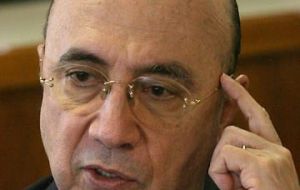MercoPress. South Atlantic News Agency
Brazil leaves basic rate unchanged at 8.75%, in divided decision
 President Henrique Meirelles is expected to leave the bank at the end of the month
President Henrique Meirelles is expected to leave the bank at the end of the month The Brazilian central bank kept its benchmark Selic interest rate at a record low 8.75% in a less-than-unanimous decision, signaling that borrowing costs may rise as soon as next month.
Policy makers kept the overnight rate unchanged for the fifth consecutive meeting in a 5-to-3 vote. Thursday’s meeting may have been the last headed up by bank President Henrique Meirelles who may resign to seek elected office this year.
In a statement accompanying the decision, similarly worded to one in January, the monetary board of the bank said it would “closely monitor” Brazil’s economic outlook until its next meeting in six weeks before “defining the next steps in its monetary policy.”
The 5-to-3 vote was the biggest split vote since a 5-to-3 vote in January 2009, when policy makers cut the Selic by a more than expected 1 percentage point. Most analysts had anticipated that the Monetary Policy Committee, Copom would raise borrowing costs.
“Assessing the macroeconomic outlook and the prospects for inflation, the Copom decided to maintain the Selic rate at 8.75%, without bias, with five votes for the monetary policy action and three votes in favor of increasing the Selic rate by 50 basis points. The Committee will carefully monitor the evolution of the macroeconomic scenario until its next meeting (April 27/28), in order to define the next steps of its monetary policy strategy”, said the short release from Copom.
Record low borrowing costs helped Brazil pull out of its deepest recession in a decade in 2009 and a revival of domestic demand may push the 1.8 trillion US dollars economy to its fastest growth in two decades this year, according to Paulo Leme, chief Latin America economist at Goldman Sachs Group Inc.
But at the same time, inflation has exceeded the bank’s target in 2010 and economists surveyed by the bank expect still higher prices by year-end. Consumer prices will rise 5.03% this year, compared to 4.83% in the 12 months through February, according to the median forecast in a weekly central bank survey of about 100 economists published March 15.
Meirelles, 64, who has served as head of the bank since president Lula da Silva took office in January 2003, faces an April 2 deadline to decide whether to resign his post to become eligible to run in October elections.
Speaking in Brasilia on Feb. 26, Meirelles said policy makers were ready to take “unpopular” steps to keep inflation in line with targets and that the political calendar wouldn’t affect monetary policy.
Over the course of five meetings beginning in January 2009, policy makers cut the Selic rate to 8.75% from 13.75% and injected about 57 billion USD into the country’s money markets. The bank last raised rates on Sept. 10, 2008, days before Lehman Brothers Holdings Inc. filed for the biggest bankruptcy in U.S. history
Brazil’s economy started rebounding in the second quarter of last year and expanded 2% in the last quarter of 2009 from the previous three months, the fastest pace in two years.
Meirelles said the economy had entered a “vigorous expansion phase” after the national statistics agency reported March 11 that retail sales jumped by a record 2.7% in January from December, signaling stronger growth to come.
Meirelles plans to resign March 31 to run for vice president alongside Dilma Rousseff, Lula da Silva’s Cabinet chief and his chosen successor, IstoE magazine reported March 10, without saying where it obtained the information.
Replacing Meirelles will be Alexandre Tombini, the director of financial regulation at the bank, the Sao Paulo-based magazine reported.




Top Comments
Disclaimer & comment rulesCommenting for this story is now closed.
If you have a Facebook account, become a fan and comment on our Facebook Page!